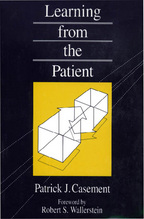Learning from the Patient
Patrick Casement
Paperback
Paperback
orderSeptember 25, 1992
ISBN 9780898621570
Price: $52.00 386 Pages
Size: 6" x 9"
Copyright Date: 1990
In one volume, this book presents Patrick Casement's two classic works, On Learning from the Patient and Further Learning from the Patient . The patient's unconscious contribution to analytic work is fully explored. Casement writes with unusual openness about what really happens in the consulting room, including mistakes—his own as well as others'. Everything in psychoanalytic theory and technique is up for questioning and for careful testing in the clinical setting. Casement provides fresh insights on familiar concepts as well as developing a number that are new; every concept is explained and illustrated with clinical examples.
“...if I was asked to recommend one book on technique for the beginning therapist, I would recommend Learning from the Patient.”
—Psychoanalytic Psychology
“The book contains a wealth of insights and ingenious ways of handling complex problems in a therapeutic relationship. It is thoroughly recommended for anyone working in psychotherapy.”
—International Journal of Social Psychiatry
“Intended for the therapist in training but...will be welcomed by the most experienced practitioner as well....The emphasis on what actually goes on in treatment and the author's openness to scrutiny are the strengths of this entertaining and informative work.”
—Psychoanalytic Books
“Casement's book is masterly in his entirely convincing account of the complexity of unconscious communications that occur between patient and therapist....If I was asked to recommend one book on technique for the beginning therapist, I would recommend Learning from the Patient....It is the best book available.”
—Arnold H. Modell in Psychoanalytic Psychology
“This is a remarkable and unusual addition to psychoanalytic literature, and a book form which any analyst, however experienced, is sure to learn something new and valuable. The future of psychoanalysis lies along the path that Casement is pointing out in this sensitive, excellent book.”
—Anthony Storr, F.R.C.P., F.R.C.Psych., F.R.S.L.
“This is a landmark book, one of the outstanding contributions to the psychoanalytic literature in recent years. With his remarkable sensitivity to the subtle manifestations of the interactions taking place in the analytic hour and his awareness of the impact of patient and analyst on each other, Patrick Casement has demonstrated how a gifted analyst can make use of the her-and-now transactions to explore the rich tapestry of thoughts, fantasies, and memories that lie behind them. This book can serve as a teaching text for all therapists who are interested in learning from a master clinician....”
—Theodore J. Jacobs, M.D.
“Casement believes that the power of the therapist lies in learning how to help a patient experience himself through the therapeutic prism and he describes this by his own clinical work with a direct openness, a disciplined compassion, and a refreshing modesty that is intrinsically elegant....A valuable psychoanalytic offering.”
—Rosalyn Benitez-Bloch, D.S.W.
“Few analysts convey better than Casement the actual feeling of work in the consulting room. His non-dogmatic but rigorous attention to the total communication of the patient represents what is best and most convincing about modern psychoanalysis. His book will be of particular value to trainees in the psychodynamic professions, but will also be refreshing to more experienced practitioners.”
—David Black, Lecturer, Westminster Pastoral Foundation, London, British Journal of Psychiatry
